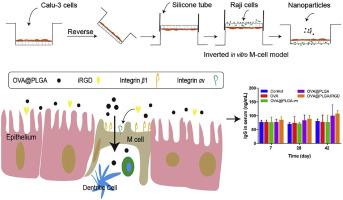Acta Pharmaceutica Sinica B ( IF 14.7 ) Pub Date : 2020-03-04 , DOI: 10.1016/j.apsb.2020.02.011 Xiaotong Yang 1 , Xianchun Chen 2 , Ting Lei 1 , Lin Qin 1 , Yang Zhou 1 , Chuan Hu 1 , Qingfeng Liu 3 , Huile Gao 1

|
In order to better evaluate the transport effect of nanoparticles through the nasal mucosa, an in vitro nasal cavity-mimic model was designed based on M cells. The differentiation of M cells was induced by co-culture of Calu-3 and Raji cells in invert model. The ZO-1 protein staining and the transport of fluorescein sodium and dexamethasone showed that the inverted co-culture model formed a dense monolayer and possessed the transport ability. The differentiation of M cells was observed by up-regulated expression of Sialyl Lewis A antigen (SLAA) and integrin β1, and down-regulated activity of alkaline phosphatase. After targeting M cells with iRGD peptide (cRGDKGPDC), the transport of nanoparticles increased. In vivo, the co-administration of iRGD could result in the increase of nanoparticles transported to the brain through the nasal cavity after intranasal administration. In the evaluation of immune effect in vivo, the nasal administration of OVA-PLGA/iRGD led to more release of IgG, IFN-γ, IL-2 and secretory IgA (sIgA) compared with OVA@PLGA group. Collectively, the study constructed in vitro M cell model, and proved the enhanced effect of targeting towards M cell with iRGD on improving nasal immunity.











































 京公网安备 11010802027423号
京公网安备 11010802027423号